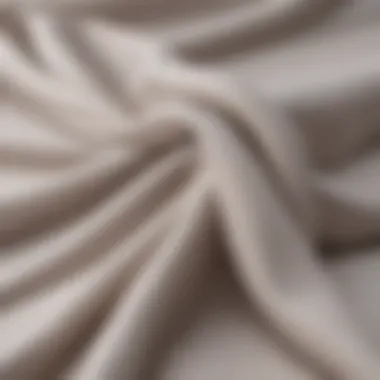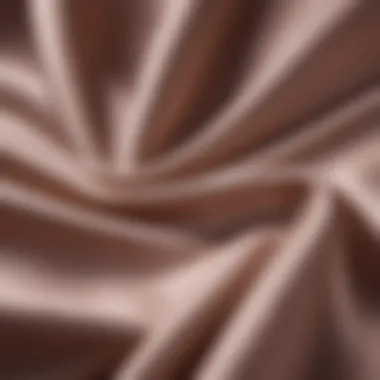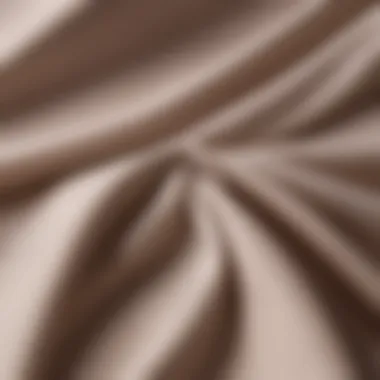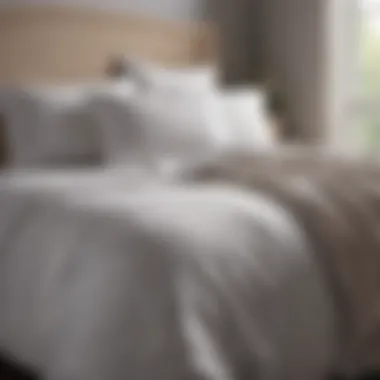Cotton Percale vs. Cotton Sateen: Key Differences Explained


Intro
Choosing the right fabric for bedding and home textiles goes beyond mere aesthetics. Understanding the distinct characteristics of cotton percale and cotton sateen can significantly influence the ambiance of a living space. This exploration aims to highlight core differences between these two popular cotton weaves, examining their unique properties and practical applications. Ultimately, the goal is to empower homeowners and design enthusiasts with knowledge that can enhance their choice for a comfortable and stylish home.
Design Inspirations
The fabric's design plays a crucial role in setting the tone of a room. Cotton percale and cotton sateen possess distinct styles that cater to different tastes in home decor.
Trending Styles
Cotton percale often features a crisp and smooth finish with a matte feel. This quality makes it a favored choice for a serene, minimalist aesthetic. Its structured nature pairs well with modern and traditional design elements alike.
On the other hand, cotton sateen is known for its luxurious sheen and silky touch. This soft drape is ideal for those who desire a more opulent feel in their spaces. Sateen lends itself well to opulent styles, such as bohemian or contemporary chic.
Color Palettes
When it comes to color selections, cotton percale tends to offer vibrant and bold hues. It's used often in playful and colorful designs, perfect for youthful spaces or dynamic master bedrooms.
Conversely, cotton sateen often embraces deeper, richer color tones. These shades complement sophisticated interiors, adding a touch of warmth without overwhelming the design.
Maintenance and Upkeep
Proper maintenance is essential to maintain the integrity and beauty of both fabrics. Each type has specific needs that should be considered for longevity.
Seasonal Maintenance Checklist
- Cotton Percale:
- Cotton Sateen:
- Wash in cold water to maintain crispness.
- Avoid bleach to prevent fabric damage.
- Use gentle detergent to preserve the sheen.
- Consider line drying to reduce wear from heat.
Cleaning and Organization Tips
- For cotton percale, consider organizing beddings according to seasonal use. Pure, crisp sets can enhance a spring refresh in the bedroom.
- For cotton sateen, prioritize care by storing it in a cool, dry space to prevent fabric degradation. Keep a close eye on any stains, as these may require special treatment to maintain the fabric’s luster.
Overall, examining cotton percale and cotton sateen reveals not just their physical attributes, but also how they can serve different lifestyles and design preferences. Rather than merely selecting a fabric, one can create intentional living spaces that reflect individual tastes through informed decisions.
Foreword to Cotton Fabrics
Cotton fabrics hold a prominent place in the textile world, influencing choices in home decor, fashion, and personal comfort. Understanding these fabrics, especially cotton percale and cotton sateen, enriches the knowledge of homeowners, interior design enthusiasts, and anyone keen on textile quality. Each fabric serves distinct purposes and offers unique attributes, making the decision between options significant.
Overview of Cotton as a Material
Cotton is a natural fiber obtained from the cotton plant. It is renowned for its softness, breathability, and versatility. The plant produces fluffy fiber, which is harvested and spun into yarn. Among the notable qualities of cotton are its hypoallergenic properties and moisture-wicking abilities. These benefits make cotton a preferred choice for countless applications—from clothing to bedding.


- Breathable: Cotton allows air circulation, making it ideal for wearing and sleeping.
- Softness: The fiber feels gentle against the skin, enhancing comfort.
- Absorbent: Its ability to absorb moisture adds to its comfort and utility.
Being conscious of cotton's origins and characteristics helps consumers make educated decisions regarding home textiles.
Importance of Weave Types
Weave type is crucial in determining a fabric's qualities and suitability for various uses. Different weaving techniques produce unique textures, appearances, and performance attributes. For example, cotton percale employs a simple, tight weave that results in a crisp finish, while cotton sateen utilizes a more complex weave, offering a smooth and lustrous surface.
- Cotton Percale: Known for its matte finish, durability, and cool feel. Suitable for warm climates.
- Cotton Sateen: Recognized for its sheen, softness, and luxurious appearance, providing an elegant touch to any setting.
Understanding these weaves aids in the selection process. It empowers consumers to choose the fabric that aligns with personal needs and decor styles, whether the aim is to create a cozy atmosphere or to achieve a sophisticated look.
Characteristics of Cotton Percale
Cotton percale is a popular choice for bedding and various textile applications. Understanding its characteristics allows homeowners and design enthusiasts to make informed decisions about its suitability for their needs. This section examines the distinct features of cotton percale, providing insights into its unique properties and benefits.
Weave Structure
Cotton percale is characterized by a simple yet effective weave structure known as a plain weave. This means that the threads are woven together in a one-over-one-under sequence. The resulting fabric has a crisp, matte finish. The tight weave creates a smooth surface that is less prone to wrinkling. It is important to note that this type of weave also contributes to the fabric's breathability. Homeowners in warmer climates will appreciate how percale allows for adequate airflow, making it a practical option for sleep comfort.
Texture and Feel
The texture of cotton percale is defined as crisp and cool. This quality makes percale an excellent choice for those who prefer a lightweight option. When you touch cotton percale, it feels smooth against the skin. Unlike other fabrics that may feel slinky or shiny, percale has a more breathable nature that can keep you feeling fresh. This texture can be particularly beneficial for individuals sensitive to heat, as it can help regulate body temperature during sleep.
Durability and Longevity
Durability is a significant factor when choosing bedding. Cotton percale stands out for its strength and longevity. The tight weave not only enhances the fabric's resilience but also gives it the ability to withstand regular washing. Furthermore, percale tends to soften over time, contributing to its appeal among those who appreciate a cozy feel. Investing in cotton percale can lead to a long-lasting product that remains comfortable and visually appealing throughout its lifespan.
"Cotton percale is an excellent choice for those seeking a fabric that balances comfort with durability."
In summary, cotton percale’s weave structure offers breathability, and its crisp texture provides a refreshing sleep experience. Additionally, its durability ensures that it can withstand the test of time. For homeowners looking to enhance their living spaces, understanding these characteristics is essential.
Characteristics of Cotton Sateen
Understanding the characteristics of cotton sateen is essential for anyone looking to make informed choices about textiles, especially home décor and bedding. Sateen has specific features that set it apart from other weaves, particularly cotton percale. Each detail contributes to the fabric's performance and aesthetic qualities, which are beneficial for homeowner applications.
Weave Structure
Cotton sateen is defined by its unique weave pattern. It employs a four-over, one-under structure, allowing more threads to be on the surface, which gives sateen its characteristic smoothness and luxurious feel. This structure results in a fabric that has a higher thread count than cotton percale. Typically, sateen fabrics boast 200 to 600 threads per square inch. The tighter weave can reflect light effectively, lending a subtle luster to the fabric. This quality enhances its appeal for decorative applications, making it more than just a practical choice.
Texture and Feel
The texture of cotton sateen is another element that distinguishes it from percale. It has a silky, soft feel that many find to be inviting for bedding. The surface of sateen is smooth and cool to the touch, creating a sense of comfort that can enhance sleep quality. This tactile quality is particularly attractive to those who might seek the indulgence of hotel-feel linens in their own home. The soft texture draws attention and adds elegance to any bedroom setting. Moreover, coton sateen is less prone to wrinkling, which makes it a practical option for everyday use.
Durability and Longevity


When it comes to durability, cotton sateen holds up well against wear and tear. Although it might feel softer and more delicate compared to its percale counterpart, sateen fabric is constructed to last. It resists fading and maintains its colors over time, which can be a significant factor for individuals who prioritize longevity in their linen investments. Regular maintenance, such as following care instructions can further enhance its lifespan. Therefore, while it may be luxurious and soft, it does not compromise on durability and can withstand the rigors of daily use.
"Choosing the right fabric goes beyond just appearance. Understanding the underlying characteristics makes a substantial difference in your selection process."
Comparative Analysis of Cotton Percale and Cotton Sateen
The process of comparing cotton percale and cotton sateen involves understanding their distinct characteristics. This analysis serves a vital role for homeowners and design enthusiasts aiming to optimize living environments. By focusing on these fabrics’ properties, it becomes easier to select the appropriate one for various applications.
The comparison underscores elements such as breathability, moisture wicking, luster, and weight. Each factor contributes to the overall experience and utility of the fabric in different settings. A thorough examination reveals not just preference but also practical considerations that might dictate choice based on individual needs or circumstances.
Breathability
When evaluating cotton percale, its breathability stands out. Percale's tight weave allows air to circulate, keeping the user cool during warm months. This feature is remarkably beneficial for those who tend to sleep hot. On the other side, cotton sateen has a denser weave that can trap heat, making it warmer than percale. For climates where ventilation is crucial, percale might be the more suitable option.
Moisture Wicking Properties
Both of these fabrics possess moisture-wicking properties, but they perform differently. Cotton percale efficiently pulls moisture away from the skin, drying quickly and providing a fresh feel. This is important for people engaging in physical activities or those who prefer a cleaner sleeping environment. Conversely, while cotton sateen also wicks moisture, its heavier texture may make it slightly less effective at drying out fast. This difference can impact comfort level, especially in humid conditions.
Luster and Shine
Sateen is characterized by its luxurious appearance. The weave creates a sheen that is visually appealing and elevates a bedroom's decor. In contrast, percale offers a matte finish, which gives a different yet equally attractive appearance. Preference between these fabric's visual aspects depends heavily on personal taste and the desired aesthetic of your living space.
Weight and Thickness
Weight and thickness are crucial when selecting bedding fabric. Cotton percale is usually lighter than cotton sateen. This quality makes percale suitable for layering; it can be used in conjunction with heavier comforters without adding excess bulk. Sateen’s thicker feel gives it a plush signature that some may find desirable in cooler weather, offering warmth and coziness.
Overall, understanding these comparative characteristics enables better decision-making for selecting cotton percale or cotton sateen. The choice is ultimately dictated by specific needs, personal preferences, and environmental factors.
Benefits of Cotton Percale
Understanding the benefits of cotton percale is crucial for discerning homeowners and interior design enthusiasts. This fabric type provides distinct advantages that cater to specific needs and preferences. The unique weaving technique creates a fabric that is both practical and versatile, ideal for various settings, particularly in warmer climates. Percale's cool and crisp finish often appeals to those who value functionality without sacrificing style.
Ideal for Warm Climates
Cotton percale is an exceptional choice for people living in warm climates. Its breathable nature allows for better airflow, keeping you cooler during hot nights. This fabric maximizes comfort by helping to regulate body temperature, which is especially vital for those prone to overheating while sleeping. The light, airy texture prevents the feeling of being weighed down by heavy materials. Consequently, many active individuals or those who struggle with night sweats find cotton percale exceptionally beneficial.
Hypoallergenic Properties
Another significant advantage of cotton percale is its hypoallergenic properties. This attribute makes it a smart option for anyone in need of sensitive skin solutions. The tightly woven fabric, combined with natural cotton fibers, resists dust mites and allergens, promoting cleaner sleeping environments. As a result, people with asthma or allergies often lean towards cotton percale. This quality enhances overall sleep hygiene, contributing to a healthier living space.
Ease of Care and Maintenance
Lastly, cotton percale fabric offers ease of care and maintenance. It is machine washable and tends to withstand regular cleaning without damage to its structure. This functionality is essential for busy households wanting to maintain a seamless balance of aesthetics and practicality. Unlike some other fabrics, percale maintains its crispness over time, resisting wrinkles and fading with proper care. In sum, its durability simplifies household chores, allowing homeowners and party hosts to focus more on enjoyment than upkeep.
"Consider choosing cotton percale for its unmatched combination of comfort, cleanliness, and convenience."


Each of these benefits makes cotton percale an appealing option. Homeowners and design enthusiasts alike should evaluate how these qualities align with their specific needs when selecting bedding and textiles for their spaces.
Benefits of Cotton Sateen
Cotton sateen offers various advantages that can enhance the experience of users. Its features make it particularly attractive for those who appreciate comfort, aesthetics, and versatility in textiles. Understanding these benefits is crucial for anyone looking to make informed choices regarding their bedding and upholstery materials.
Softness and Comfort
One of the most significant benefits of cotton sateen is its exceptional softness. The unique weave of cotton sateen creates a smooth fabric that feels soft against the skin. This softness is often associated with higher thread counts, which can contribute to a more luxurious feel. Consumers often report that cotton sateen bedding provides a cozy embrace, making it ideal for sleep. The comfort it provides becomes crucial, especially for those who prioritize a good night’s rest. The gentle surface of cotton sateen can also be beneficial for people with sensitive skin, reducing irritation.
Luxurious Appearance
Cotton sateen has a distinct sheen that gives it a luxurious appearance. This reflective quality elevates the overall aesthetic of home decor. By choosing cotton sateen, individuals can add a touch of elegance to their bedrooms and other living spaces. Unlike other fabrics, which may appear dull or plain, cotton sateen has a richness in look that enhances visual appeal. This feature can be particularly advantageous for homeowners looking to impress guests or create a welcoming atmosphere in their homes.
Good for Layering
Cotton sateen is also appreciated for its ability to work well in layering. This quality makes it a favorite among interior design enthusiasts. The smooth texture and draping properties of cotton sateen allow it to pair beautifully with various other materials. Whether used for bed covers, pillows, or other decorative elements, cotton sateen can complement different fabrics effortlessly. Layering with cotton sateen adds depth and dimension to a room, creating a sophisticated, curated look. This versatility makes it a practical choice for changing seasonal decor without needing to replace entirely all bedding or furnishings.
"The unique combination of softness, luxury, and versatility makes cotton sateen a preferred choice for those who value aesthetic and practical benefits in their textiles."
Choosing Between Cotton Percale and Cotton Sateen
Considerations for Sleep Comfort
Sleep comfort is paramount when choosing between cotton percale and cotton sateen. It is essential to consider how different fabrics perform in relation to body temperature regulation. Cotton percale tends to be crisp and breathable, excellent for warmer climates or those who sleep hotter. It allows air to circulate, preventing overheating during the night. On the other hand, cotton sateen is often preferred for its softer feel and warmth. This fabric is denser, providing a cozy effect that some may find comforting, especially in cooler seasons. Think about your personal sleep habits and preferences when making a choice.
Decorative Preferences
Choosing the right fabric also extends to decorative preferences. Cotton percale features a matte finish that lends itself well to a more understated or casual décor. It can easily blend with a variety of color palettes and styles, from minimalist to traditional. Conversely, cotton sateen has a subtle sheen, offering a more luxurious appearance that can elevate the aesthetic of a bedroom. If you aim for a more opulent look, sateen may be the way to go. Consider how the fabric’s characteristics align with your interior design goals.
Budget Considerations
Cost is another element that should guide your choice. While both cotton percale and cotton sateen can be found at various price points, they can differ based on quality and brand. Cotton percale is generally more affordable, making it a practical option for those on a budget. However, invest in high-quality sateen can provide long-term benefits in terms of durability and comfort. It is beneficial to evaluate your budget and weigh it against the desired characteristics of the fabric.
Ultimately, the decision between cotton percale and cotton sateen must intertwine personal preferences with specific needs relating to comfort, decor, and budget.
By carefully assessing these elements, one can confidently select the fabric that enhances not just the bedroom aesthetic but also the quality of sleep.
Finale
The conclusion serves a critical role in summarizing the core insights gained throughout this article regarding cotton percale and cotton sateen fabrics. Understanding these differences is essential for consumers looking to enhance their living spaces with the right bedding materials. Each fabric carries its own set of characteristics, benefits, and ideal use cases, making them suitable for distinct preferences and environments.
In evaluating cotton percale, one can appreciate its breathability and crisp texture. This makes it a favorable choice for warmer climates and individuals who prioritize cooling properties while sleeping. Conversely, cotton sateen offers a soft and luxurious finish, appealing to those seeking comfort and a more sophisticated aesthetic in their interiors.
Moreover, considerations such as durability and care requirements significantly impact fabric selection. Cotton percale's ease of maintenance contrasts with the higher maintenance fabric sateen may require to preserve its sheen. Thus, a budget-conscious consumer must weigh these factors against their lifestyle needs and aesthetic desires.
Ultimately, making an informed choice between cotton percale and cotton sateen enables homeowners, interior design enthusiasts, and hosts to not only enhance their space but also ensure lasting satisfaction with their textile selections. A deeper understanding of fabric properties translates to better decision-making and an improved experience in daily life.
Final Thoughts on Fabric Selection
When selecting between cotton percale and cotton sateen, consider the specific qualities you value most. If breathability and a fresh feel are priorities, cotton percale may be ideal. Yet, if luxurious softness and a glossy finish resonate more, cotton sateen is likely your best option. Assess your personal comfort preferences alongside factors like climate and maintenance. Such careful consideration will guide you in achieving a bedding arrangement that aligns with both your aesthetic vision and practical needs.







